Transforming Engagement Rings into Wedding Rings
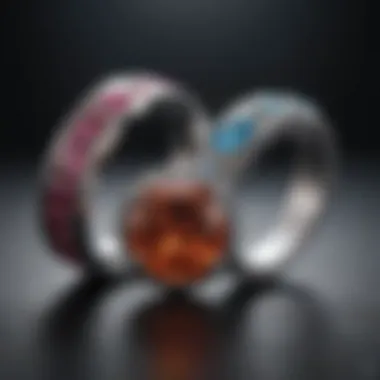
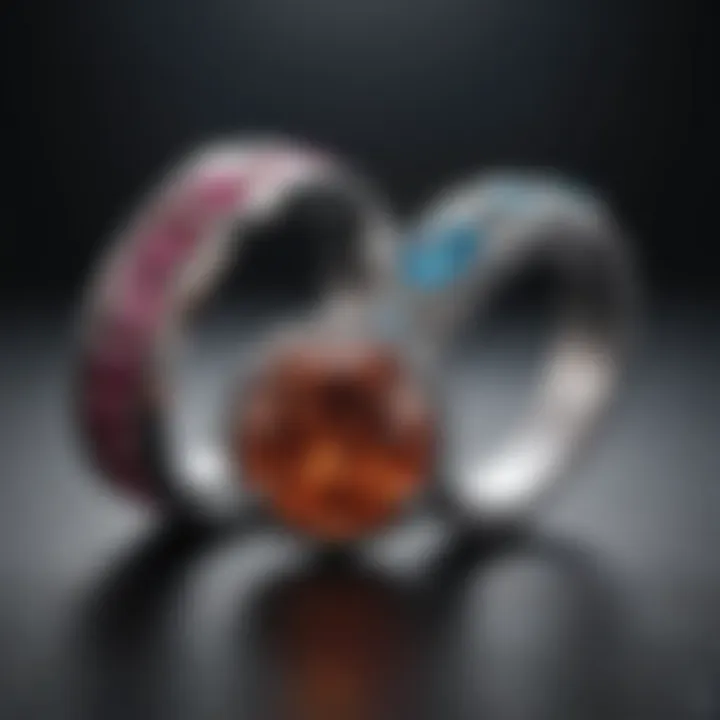
Intro
Engagement rings have long been regarded as symbols of commitment and romance, often capturing the hearts of individuals and couples alike. However, the evolving dynamics of love and relationships have led to a fascinating phenomenon: the transformation of engagement rings into wedding rings. This practice not only carries emotional weight but also reflects cultural significance, as it intertwines the stories of couples with their unique choices in jewelry.
In many cultures, the notion of wearing the same ring for both engagements and weddings signifies unity. It’s not just a trend but a deep-rooted custom that resonates with individuals across different backgrounds. By examining the multifaceted implications of this choice, we can uncover the rich tapestry of meanings behind the rings.
As we delve deeper into this exploration, we will discuss the historical contexts that have shaped these practices, the considerations couples must take into account, and the broader implications of such choices in society. Let's first take a closer look at the gems that often adorn these rings, as they hold much more than just aesthetic appeal.
Prologue to Dual Purposes of Rings
Rings have long held a significant place in human relationships, serving as potent symbols of love and commitment. In the context of engagement and wedding rings, these pieces of jewelry take on dual roles that extend beyond mere adornment. This section explores the multifaceted nature of these rings, highlighting how they embody not only personal emotions but also cultural narratives.
Understanding the dual purposes of these rings is essential for couples embarking on the journey from engagement to marriage. It's not just about choosing a ring that looks pretty; it's about selecting something that reflects shared values and intentions—a piece that will carry memories throughout the years.
Both engagement and wedding rings encapsulate profound meanings. They bridge the gap between pre-wedding commitments and the solemn vows exchanged during marriage. Each ring tells a story, often deeply rooted in the couple's individual and shared experiences. The decision to use an engagement ring as a wedding ring can simplify matters while maintaining the significance of what these rings represent.
Consider the benefits of transforming an engagement ring into a wedding ring. First off, you get to save on costs, which can be a relief in today's economic climate. Since the engagement ring already bears emotional significance, it can also reduce the stress associated with selecting yet another piece of jewelry. Plus, there's a certain elegance in continuity; it signifies that the journey from engagement to marriage is seamless, connected.
Ultimately, this topic isn't solely about the rings themselves but also speaks to modern relationships and how they evolve. As perspectives on traditions shift, the conversations couples have about their choices become vital. By examining these dual purposes, readers can appreciate the depth behind the jewelry they wear, making informed decisions that resonate with their values and experiences.
Defining Engagement and Wedding Rings
Engagement rings and wedding rings, while often used interchangeably in casual conversation, serve distinct roles in the timeline of a relationship. An engagement ring typically marks the promise of marriage, symbolizing a couple's commitment to each other. It's characterized by its dazzling stones, often featuring a prominent diamond, which signifies the clarity and brilliance of their love.
In contrast, a wedding ring symbolizes the bond created during the marriage ceremony. This ring tends to have a simpler design, often crafted in precious metals without the singling stone that characterizes most engagement rings. It serves as a continuous reminder of the vows taken and the life shared.
Both types of rings carry immense emotional weight, but understanding their unique definitions helps couples navigate through traditions, expectations, and sentimental values.
Cultural Significance in Different Societies
Across various cultures, engagement and wedding rings hold unique significance—the sentiment of love transcends geographical boundaries, yet the expressions differ markedly. In Western cultures, for instance, engagement rings are predominantly worn by women and often are designed with prominent diamonds, speaking to long-standing societal norms around masculinity and femininity.
In contrast, some cultures celebrate the idea of a unity ring, exchanged between couples as a symbol of their partnership rather than a singular focus on the engagement. For example, in certain areas of India, it is common for both partners to exchange rings, emphasizing mutual commitment rather than gender-specific roles.
The meanings of these rings are also deeply embedded in local traditions and religious contexts. Some societies incorporate specific gemstones or designs that reflect local customs, while others attach spiritual significance to the rings themselves. For instance, the use of woven rings among Celtic peoples symbolizes the eternal nature of love, weaving the couple's destinies.
Ultimately, exploring the cultural significance of engagement and wedding rings reveals a rich tapestry of human experiences—showing us that, while styles may differ, the underlying emotions remain strikingly similar. From the cultural colors of a wedding ceremony to the family heirlooms passed through generations, these rings encapsulate far more than we might initially grasp.
Historical Overview of Engagement and Wedding Rings
The story of engagement and wedding rings is steeped in tradition, culture, and changing societal norms. Understanding the historical context of these rings illuminates their significance today and affirms why couples may consider transforming their engagement rings into wedding rings. This exploration provides key insights into how these symbols of love have evolved, thus allowing individuals to truly appreciate the weight they carry in personal and cultural narratives.
Origins of Engagement Rings
Engagement rings trace back to ancient times. This has not always been the case as we know it today, often taking root in symbolic exchanges that represented a binding promise rather than flashy adornments. The earliest instances appear in ancient Egypt, where a braided ring of reeds or leather served as a token of commitment. It was an inauspicious start compared to today’s diamond rings, but it set the groundwork for a tradition that joined emotional significance to material items.
Interestingly, the Romans also contributed to this narrative by adding an iron ring to the mix—symbolizing strength and permanence. Iron transformed over time into gold, as noted history unfolded. By the 15th century, it was not uncommon for European aristocrats to present rings embellished with gemstones. The tradition grew stronger, feeding the societal appetite for opulence but also the idea that an engagement ring signifies one's social status.
Bringing it to a modern context, the De Beers diamond advertising campaign in the 20th century greatly popularized the diamond engagement ring, cementing its status as a symbol of love and commitment for many. In albeit simple terms, the evolution of engagement rings highlights the cultural hue in which love has been communicated and celebrated through the ages.
Evolution of Wedding Ring Traditions
The journey of wedding rings reveals a diverse array of customs, each telling a different tale. Contrary to the widely held belief that wedding bands are a modern invention, their history is surprisingly rich. Similar to engagement rings, wedding bands can be traced back to ancient Egyptians who exchanged braided reeds or leather during marriage ceremonies. They symbolized eternal love, their circular shape an emblem of infinity.
In ancient Rome, it became customary for brides to wear a ring on the third finger of the left hand, based on the belief that it housed the vein of love, or the 'vena amoris'. This belief proliferated, serving as groundwork for contemporary practices.
As societies evolved, so did the materials and styles of wedding bands—from simple metal bands to intricate designs laden with gemstones. By the time the Renaissance rolled around, the concept had morphed into a dualistic representation overshadowing societal values:
- Simplicity vs. Complexity: While minimalist designs often reflect modern-day sentiments, lavish creations evoke the richness of love.
- Cultural Nuances: From the plain gold bands in Western traditions to ornate designs in various cultures, the wedding ring crafts a cross-cultural narrative of love’s enduring nature.
"The evolution of wedding rings is much like the story of love itself—full of twists, bends, and changes that define its essence in different contexts."
In essence, engagement and wedding rings have developed alongside human emotion, anchored in historical significance. As couples today contemplate using engagement rings as wedding rings, they do so not only acknowledging the past but weaving their personal stories into this rich tapestry of traditions.
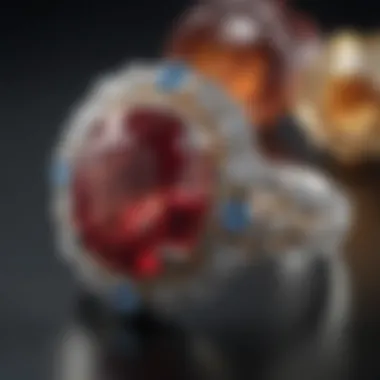
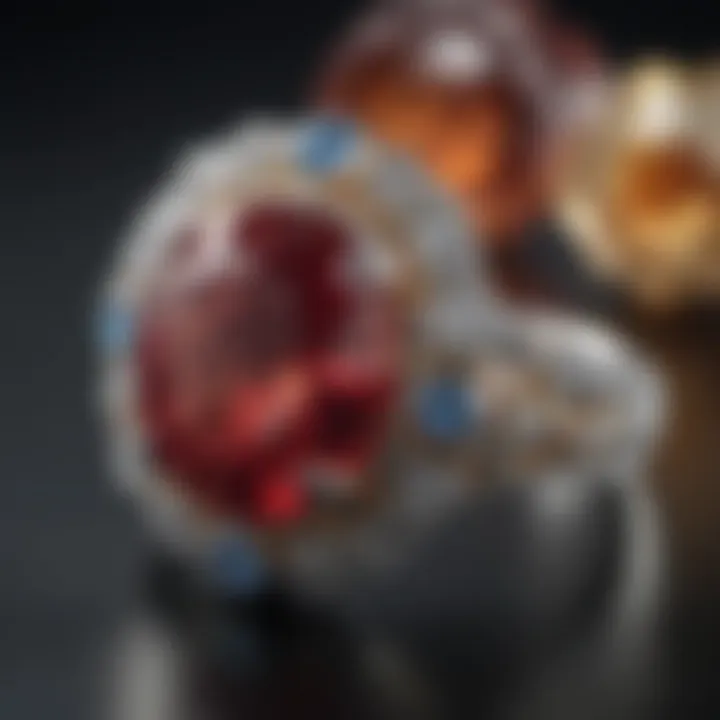
Symbolism Behind Engagement and Wedding Rings
Engagement and wedding rings serve as much more than mere adornments; they encapsulate profound symbolism reflecting love, commitment, and the bonds of marriage. These items are steeped in tradition, yet they also adapt to modern definitions of love and partnership, making them a vibrant topic of discussion. Understanding the symbolism behind these rings offers insight into their significance, not only as personal tokens but also as cultural heirlooms.
Love and Commitment
Love is the cornerstone upon which engagement and wedding rings are built. An engagement ring, often featuring a prominent gemstone, symbolizes the promise of a future and the commitment to nurture a partnership. The circle of the ring itself signifies eternity—a closed loop with no beginning and no end. This resonates deeply in a relationship where two individuals vow to support and cherish one another.
However, the transition of an engagement ring to a wedding ring can serve as an added layer of meaning. It reflects a continued journey together—like turning a page in a captivating book, where chapter one has been set with an engagement, and chapter two unfolds with the wedding. Couples often find that it deepens their connection, as the engagement ring takes on new significance within their shared narrative.
Additionally, some couples choose rings made from precious materials not only for their beauty but also for their durability, reinforcing the idea that love can withstand the test of time. Everyone from seasoned jewelers to casual enthusiasts can appreciate the art in crafting pieces that symbolize lasting connections.
The transition from engagement to wedding rings is not just a physical exchange; it’s a celebration of shared experiences and mutual growth.
Cultural Variations in Meaning
Cultural variations significantly shape the meanings attributed to engagement and wedding rings. While oftentimes these rings are perceived as universal symbols of love, different cultures imbue them with distinct qualities and practices.
For instance, in some Asian countries, gold rings are prevalent, viewed as symbols of prosperity and good fortune in marriage. In contrast, in certain Western cultures, engagement rings often feature diamonds and other gemstones, reflecting both personal taste and societal values surrounding wealth and status.
Moreover, in various Indigenous cultures across the globe, rings may serve functional roles in rituals signifying union, sometimes being crafted from natural materials like wood or animal bone. These variations illustrate how the underlying themes of love and commitment manifest differently across customs and traditions—even while sharing the common thread of partnership.
Here are a few cultural interpretations to consider:
- Western Cultures: Diamonds symbolize wealth, commitment, and enduring love.
- Eastern Traditions: Gold is favored for its association with prosperity and longevity.
- Indigenous Practices: Natural materials may create rings signifying unity and connection with nature.
As such, the symbolism of engagement and wedding rings is far from static; it evolves with societal movements, personal beliefs, and family traditions, incorporating layers of meaning that beautifully reflect the lives of the couples in question. This multifaceted approach to understanding the rings encourages couples to think deeply about what their jewelry represents in their unique relationship stories.
Practical Considerations for Using Engagement Rings as Wedding Rings
When it comes to the significant moment of saying "I do," the choice of rings cannot be understated. Using an engagement ring as a wedding ring is a growing trend and it comes with its own set of practical considerations. Couples should think through various elements, such as durability and wearability, as well as how the engagement ring will fit alongside other jewelry they own. This decision is not merely a matter of aesthetic but engages with the overall experience of wearing and caring for these cherished symbols.
Durability and Wearability
One of the first things to consider when transforming an engagement ring into a wedding ring is its durability. Wedding rings usually undergo daily wear and tear more than engagement rings, often getting bumped against hard surfaces or exposed to various elements. Therefore, how well does an engagement ring stand up to this kind of treatment?
Factors that play into the durability of an engagement ring include the materials used in the band and the way the stone is set. For instance, rings made from platinum tend to be more durable than those made from gold, and certain settings, like bezel settings, provide better protection for the stones compared to prong settings.
"The ring's durability and wearability can greatly affect a couple's day-to-day life, especially if one works with their hands. An easily damaged ring could lead to frustration rather than happiness."
Wearability is another critical aspect when deciding on this transition. Consider whether the engagement ring feels comfortable on the finger during prolonged wear. Does the design get in the way or cause irritation? Comfortable rings become second nature, while uncomfortable ones can be a constant reminder of their bulk. It’s worthwhile to pay a visit to a jeweler or try it on a few times under different scenarios, like running errands or fancy outings, before making a decision.
Matching with Other Jewelry
Another dimension to explore is how well the engagement ring matches with other jewelry items a couple may desire to wear. Wedding rings are often stacked or paired with other adornments like bracelets or necklaces. Think about the overall aesthetic you aim to present.
When considering matching styles, pay attention to the metal types, colors, and designs in your existing collection. For example, if your engagement ring is a yellow gold solitaire, pairing it with a white gold or silver band may not create the visual harmony you’re looking for.
A few things to keep in mind:
- Metal Compatibility: Whether it’s gold, silver, or platinum, each metal carries its own weight and aesthetic qualities.
- Design Cohesion: Consider if the engagement ring's design aligns with any other rings or jewelry pieces. Floral motifs may not seamlessly blend with geometric patterns, for example.
- Stacking Versatility: Some rings look better when stacked together, while others may overwhelm a hand if combined carelessly.
By weighing these factors thoughtfully, couples can ensure that their choice isn’t just sentimental but also practical. As they navigate their preferences and lifestyle, being mindful of durability and compatibility will help them cherish their rings for many years to come.
Economic Perspectives on Engagement and Wedding Rings
Understanding the economic implications of engagement and wedding rings is essential for couples navigating their journey from engagement to marriage. This section sheds light on the financial aspects of these significant pieces of jewelry. With ever-increasing costs attached to weddings and possessions, knowing the economic dynamics can help partners make informed choices about their purchases.
Cost Implications of Dual Use
The practice of using an engagement ring as a wedding ring can pose several financial advantages. By employing the same piece for both occasions, couples can save significant money, which they might otherwise spend on separate rings.
- Budget Consciousness: In the modern financial climate, being budget-friendly is on top of many couples' minds. A shiny engagement ring can transition into a wedding band without accruing additional expenses.
- Reallocation of Funds: Money saved on a wedding ring can go toward other essentials, like a honeymoon or setting up a new home. Priorities can shift towards experiences rather than material possessions.
- Price Variability: Engagement rings typically come at a higher price due to the emphasis on gemstones and settings. The possibility of lowering total expenditures while retaining a cherished piece can be appealing to many.

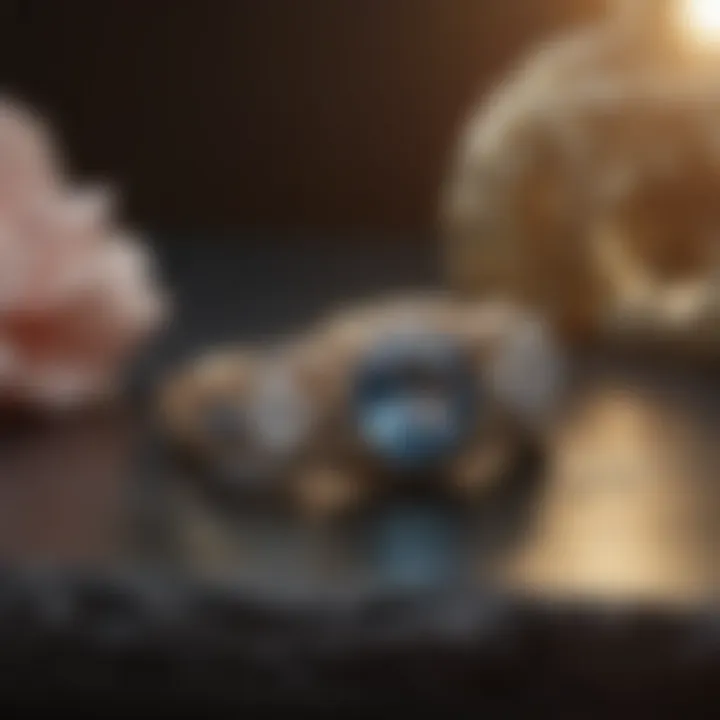
Some couples choose to customize their engagement rings, equipping them with a less formal feel to use at the wedding. This is a tactic that balances practicality with personal expression, ensuring that the dual-use ring fits comfortably into both events.
Value Retention in Different Rings
The concept of retaining value in jewelry is a topic of intrigue among gemstone enthusiasts and collectors alike. If you're pondering whether your engagement ring will stand the test of time financially, several components come into play.
- Market Demand: Some brands, like Tiffany & Co., maintain better resale value due to strong market demand. Rings that are associated with prestigious jewelers often have a higher resale potential.
- Materials Matter: Rings made with precious metals and high-quality stones generally hold their value better than those with lower-quality materials. Diamond rings, for instance, are typically seen as a more stable investment than, say, costume jewelry.
- Condition and Care: How well a ring is maintained can also affect its resale value. Proper cleaning and care can create a robust secondary market value for engaged couples considering the future.
“Investing in quality at the start can mean wise budgeting later, especially if you keep an eye on trends and market value.”
As couples transform engagement rings into wedding rings, it’s important to consider the economics involved. Value retention gives them a long-term perspective while considering the immediate pleasure brought by these beautiful symbols of commitment. Investing sensibly makes each ring not just a symbol of love, but also a smart financial decision.
Personal Stories: Real-Life Experiences
Personal narratives serve as a powerful lens through which one can examine the nuances of transforming engagement rings into wedding rings. By weaving together the emotional fabric of individual experiences, we can extract insights that transcend mere practicality. Such stories not only highlight the diverse motivations behind the switch but also capture the essence of love and commitment that these rings symbolize.
Couples Who Made the Switch
When couples decide to repurpose or wear their engagement rings as wedding rings, the anecdotal evidence often reveals a myriad of motivations. One couple, Sarah and James, found themselves looking to save on costs. Initially, they saw the wedding ring as an additional expenditure. However, they soon discovered that Sarah's intricate sapphire engagement ring, which was a family heirloom, could seamlessly transition to a wedding band that retained emotional value. This approach not only allowed them to stay within their budget but also linked their ceremony to family heritage.
On the other hand, Mia and Jake found that the act of wearing the engagement ring post-wedding infused their marriage with deeper meaning. They recalled how Mia's commitment ring, adorned with meaningful carvings, represented a milestone in their journey. By opting to wear it alongside their wedding bands primarily for sentimental reasons, they created a connection to their past while forging a new chapter in their lives.
These anecdotes provide a rich tapestry of reasons why couples choose to forgo the traditional route. They emphasize economic considerations without compromising on emotional significance.
Emotional Reactions and Sentiment
The process of transforming rings carries profound emotional weight for many individuals. Often, the switch from engagement to wedding rings encapsulates a full-circle moment that elicits widespread sentiments. In a way, it becomes a tangible representation of a love story, presenting the journey of companionship, trials, and triumphs.
For instance, many couples experience a swell of nostalgia when reflecting on their engagement moments. Several partners have shared how donning the same ring that sparked their proposal strengthens the bonds of their union. For them, the transition isn't merely about changing the type of ring but re-experiencing those cherished moments.
“Wearing my engagement ring again felt like I was holding onto a piece of our story,” shared Emilia, an advocate for sustainable jewelry practices. This sentiment resonates profoundly, reiterating that the value lies not just in the materials but in the memories they encapsulate.
Feelings of pride and personal significance are also common phenomena. As individuals customize their rings or select modifications to fit their evolving styles, they often experience a sense of empowerment. This customization process allows for a personal narrative to emerge, resonating deeply with both partners. It emphasizes that love is ever-changing; rings should reflect that evolving relationship.
In sum, the realm of personal stories surrounding the dual use of engagement and wedding rings demonstrates the intricate interplay of practicality, culture, and sentiment. Through diverse experiences, couples illuminate their journeys, allowing others to reimagine their own relationships and choices in jewelry.
Design Considerations When Using an Engagement Ring as a Wedding Ring
Choosing to use an engagement ring as a wedding ring is not just a practical choice; it’s also a deeply personal one. Various design considerations come into play while making such a decision, impacting both the aesthetics and functionality of the ring. Understanding these elements ensures that the ring remains not just a symbol of love but also a fitting representation of the couple’s journey together.
Setting Styles and Compatibility
When transforming an engagement ring into a wedding ring, the setting style becomes critical. It’s essential to consider how the engagement ring's design will pair with the wedding band. Popular settings like solitaire or pavé each offer distinct looks, and their compatibility can dramatically change the overall appearance of the rings when worn together.
For instance, a solitaire engagement ring, known for its minimalistic beauty and simplicity, pairs well with a sleek, unadorned wedding band. Conversely, a more ornate setting like a halo can clash with a detailed wedding band, leading to a visual overload. Choosing a well-matched setting creates a harmonious look and allows both rings to shine without overshadowing the other.
Additionally, a practical point to note is the footprint of the rings. The engagement ring should sit flush against the wedding band, preventing unnecessary wear and tear. Lovely patterns like twist or side-stones might create gaps that can cause discomfort. Thus, it's wise to take into account how the rings will interact when placed next to each other.
"A good design isn’t just about looking pretty; it’s about functioning well in real life."
Custom Modifications and Enhancements
As couples look to personalize their rings, custom modifications become a popular option. You can change various elements of the engagement ring to make it more suited to the dual purpose of a wedding ring. For example, some may opt to add extra diamonds or gemstones to the band or modify the prongs to ensure a more secure fit.
These enhancements can not only make the wedding ring more visually compelling but also carry significant emotional weight. Adding a small engraving on the inside band or integrating family heirlooms into the design are ideal ways to imbue the ring with sentiment. Personal touches like these add not just beauty but also a narrative that can be passed down, enriching its significance over generations.
Another aspect worth considering is the metal choice. Depending on lifestyle and personal taste, couples may want to switch the metal of the engagement ring or the wedding band. While gold is classic, materials like platinum or palladium are exceptional for longevity, often proving more durable for everyday wear. Knowing that one’s ring can withstand the rigors of daily life is an added comfort for many couples.
In summary, paying attention to design considerations makes a colossal difference in transforming engagement rings into wedding rings. From ensuring the right setting styles to personalizing through custom modifications, every choice woven in here resonates with the love story behind the rings.
Reflecting Modern Attitudes Toward Marriage
Changing Views on Tradition
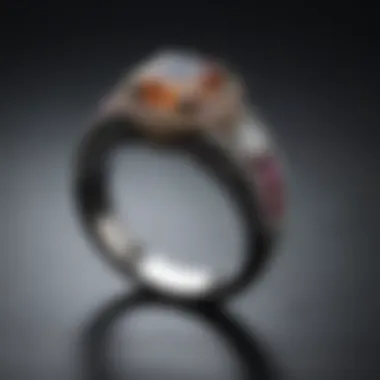
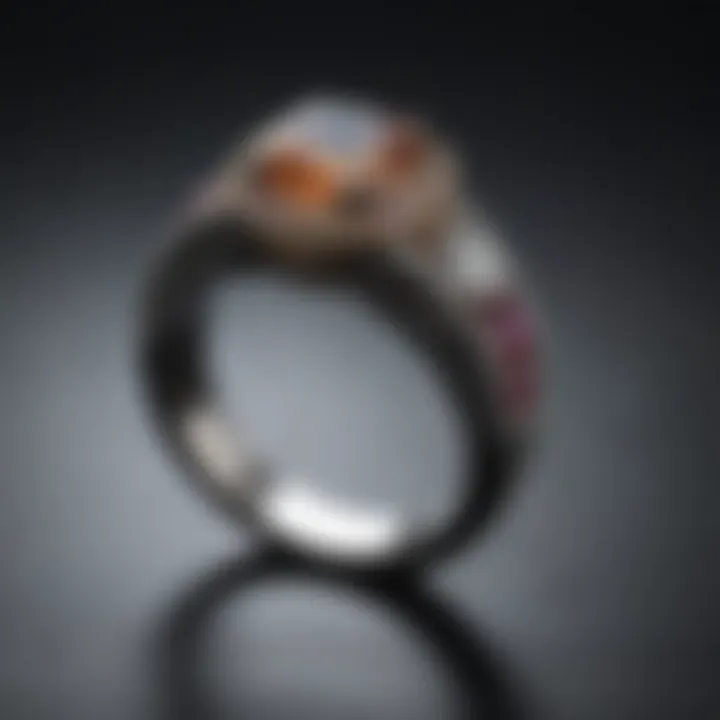
The way we look at marriage and the symbols associated with it is shifting, that’s for sure. The traditional practices around engagement and wedding rings are no longer set in stone. Nowadays, couples are more inclined to carve their own paths, reinventing customs that don't resonate with their beliefs or lifestyle. This change is largely a response to modern values, where individuality and personal choice often take precedence over outdated societal norms.
People used to believe that marrying meant adhering strictly to customs, like sticking with the same wedding band design or ensuring the engagement ring matched perfectly. But recent trends show that many are tossing those notions out the window. The preference for unique and personalized pieces means that engagement rings are finding new roles as wedding rings, and it’s becoming quite common, almost a badge of honor to showcase one-of-a-kind designs and twists on tradition.
In fact, according to a recent study, a significant percentage of couples are opting for customized rings that tell their unique love stories—tailored designs reflecting personal memories or styles rather than conventional expectations. This attitude reflects a broader cultural shift towards valuing experiences and relationships over rigidly following traditions.
Personalization and Meaning
When it comes to rings, personalization is becoming paramount. Couples are keen to express their identities through their jewelry choices. Why settle for cookie-cutter designs when you can create something that genuinely embodies your journey together? The significance of personalization goes beyond aesthetic appeal; these choices often encapsulate shared memories, events, or symbols that resonate deeply with each couple's narrative.
For instance, consider a couple who got engaged during a trip to Greece. Instead of a standard ring, they might choose a design featuring elements reminiscent of that vacation—perhaps a turquoise stone symbolizing the Aegean Sea's beauty or a band that mimics the waves they loved. This isn't just a ring; it's a wearable memory.
Importance of Customization
Customizing rings can also be a way to carry on a loved one's legacy. An engagement ring from a grandparent, reimagined into a wedding band, serves more than just artistic purposes; it becomes a vessel of family stories, love, and commitment that transcends time.
Moreover, the emotional significance attached to a carefully crafted piece can forge stronger connections between partners. By engaging in the design process together, couples share their values, inspirations, and dreams, weaving together personal stories that reinforce their commitment.
"In the end, it’s not just a ring. It’s a narrative—a story crafted with every detail implemented at the pair’s decision."
It's evident that modern attitudes toward marriage are evolving, reflecting a collective desire for authenticity and meaning in relationships. As we navigate through these transformative shifts, embracing personal narratives in engagement rings as wedding rings is just one way to honor the journey of love.
The Role of Jewelers in Customization
When it comes to the transformation of engagement rings into wedding rings, jewelers play a pivotal role. They are the creative force behind personalization, ensuring that a couple’s unique story can be intricately woven into a beautiful piece of jewelry. This segment dives into how jewelers facilitate this transformation and the myriad of benefits that arise from their expert involvement.
Collaborating with a Jeweler
The relationship between couples and jewelers is not just transactional; it’s often a partnership that fosters trust and creativity. Engaging a professional jeweler can significantly enhance the process of transforming an engagement ring into a wedding ring. Here are some key elements involved in this collaboration:
- Understanding Preferences: Jewelers offer a wealth of knowledge about styles, metals, and gemstones. This expertise can guide couples in making informed decisions that reflect their personal tastes.
- Design Options: A skilled jeweler can suggest various design modifications, from subtle engraving to complete ring remakes. This can include adjusting the setting or even adding additional stones.
- Technical Skill: Customization requires a deft touch. Jewelers possess the technical skills needed to ensure the integrity and durability of the ring are maintained throughout the alteration process.
- Creating a Connection: A good jeweler doesn't just focus on the ring; they prioritize the relationship with the couple. This connection often leads to enhanced creativity in designs that express the couple's journey.
In short, collaborating with a jeweler provides a tailored experience that aligns closely with a couple’s vision for their rings, making them feel more meaningful and personal.
Crafting a Unique Narrative
Every piece of jewelry tells a story, and for couples looking to combine their engagement ring with their wedding band, this narrative becomes even richer. Jewelers assist in crafting a unique narrative through the following means:
- Personalization: Incorporating elements such as initials, significant dates, or even symbols that resonate with the couple adds depth to the piece. This personalization transforms a conventional ring into a cherished heirloom.
- Symbolic Design: Jewelers can help translate the significance of relationships into design motifs—think infinity symbols or intertwined bands representing unity.
- Cultural Elements: Many couples wish to reflect their cultural heritage in their jewelry choices. Jewelers experienced in various cultural motifs can infuse traditional designs or techniques into modern creations.
When the wedding ring reflects a couple's unique experience and shared values, it not only serves as a beautiful ornament but also as a lasting testament to their love story.
"A ring is not just metal and gem; it's a piece of your life's story crafted into a timeless token that binds hearts together."
In essence, the intricate dance between jewelers and couples serves as the foundation for creating wedding rings that encapsulate personal narratives. Through collaboration and creativity, these artisans breathe life into the rings, ensuring they are not merely objects but rather cherished symbols of commitment and love.
Ending: Rethinking Jewelry Traditions
In the landscape of modern relationships, the traditional roles of engagement and wedding rings have begun to shift. Individuals and couples now navigate a sea of personal choices, often eschewing conventional norms in favor of options that resonate more closely with their unique experiences and values. This evolution in thinking challenges the age-old customs that dictate how rings are perceived and signifies a broader cultural transformation regarding the meaning imbued within these pieces of jewelry.
When one contemplates the transition of an engagement ring into a wedding ring, several significant factors come into play. First, there's the emotional weight attached to an engagement ring, often given as a tangible promise of love and commitment. This initial gift carries with it memories and sentiments that couples may find too valuable to set aside when it comes time for the wedding. Utilizing that precious ring in the wedding ceremony can serve as a poignant reminder of their journey together, ultimately adding deeper layers to its meaning.
Moreover, this transformation also brings economic considerations to light. Many enthusiasts point out that the costs associated with purchasing a separate wedding ring can be substantial. By opting to modify an existing engagement ring instead, couples can merge traditions with practicality, preserving their financial resources while still celebrating their union.
This dialogue surrounding the redefinition of jewelry traditions invites individuals to think critically about their personal choices. Those who might have simply conformed to expectations are stepping back to ask why they engage in certain traditions. Doing so allows couples to create a more authentic narrative that aligns with their life stories. They can choose designs and symbols that reflect their personal journey rather than simply adhere to trends or traditions.
Personal Choice and Meaning
At the heart of this discussion lies the core idea of personal choice. Each couple carries their own story—a narrative shaped by shared experiences, values, and dreams. As such, the decision to use an engagement ring as a wedding ring is not merely a practical matter, but a profound expression of identity and intention. Couples may find comfort in customizing a piece that already represents their bond, thereby reinforcing the very reasons they chose each other in the first place.
The significance attached to these choices varies dramatically across different cultures and communities. For some, a ring is not just a piece of jewelry; it's a cultural artifact steeped in history, signifying the union of two families or communities. Others may embrace a more modern, flexible approach, where the ring serves as an individualistic expression of love, creativity, and commitment.
Embracing Personal Nuances in Wedding Rings
Embracing personal nuances is about recognizing that wedding rings can embody more than just a symbol of marital status. They can be a canvas reflecting the couple’s values, adventures, and commitments. For instance, a couple may choose a unique design that incorporates elements from both engagement and wedding aesthetics, creating a piece that tells their specific story.
In an age where individuality is celebrated, opting for a wedding ring that blends the traditions of engagement rings can also pave the way for more inclusive decisions. It provides a platform for couples to explore various interpretations of love, nurturing connections to their past while innovating for their future.
"Jewelry is not just about adornment; it's a chance to share your unique love story with the world."
By approaching wedding rings through this lens, couples can create lasting memories not just through the rings themselves, but through the very process of redefining what those rings represent. In doing so, they ensure that their symbols of love remain reflective of their journey, offering a powerful reminder that true connection goes beyond mere materiality—it’s about understanding, choice, and the shared adventure into the unknown.



